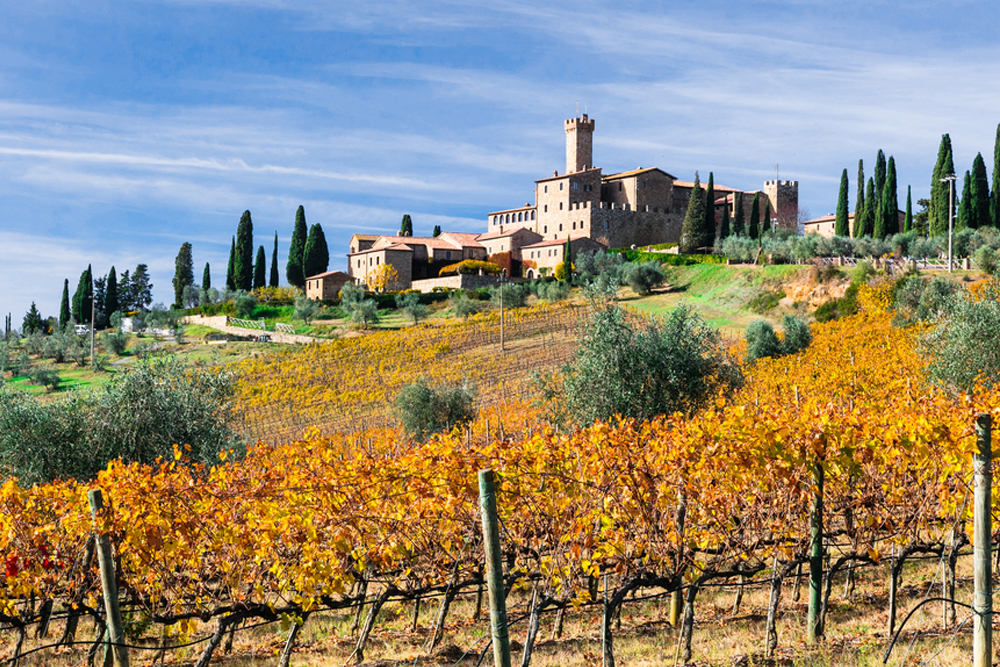The Wine Appellation: Montalcino
Montalcino’s location in southern Tuscany, 30 miles east of the Mediterranean coast, benefits from reliably warm and dry conditions thanks to the rain shadow effect created by Mount Amiata, a dormant volcano to the south. The small hilltop town and its surrounding patchwork of hillsides were relatively unknown before the 1970s, save for highly rare wine vintages released by the legendary Biondi-Santi estate, credited with inventing the wine style now called Brunello di Montalcino in 1865.
This area 26 miles south of Siena retains a long association with viticulture and wine production, as suggested by evidence dating back 2,000 years to the Etruscan civilization. Here, the noble Sangiovese grape variety, specifically its compact, thick-skinned Grosso clone, ripens exceedingly well. Limestone-rich marl soils, locally known as Galestro, define the northern half of Montalcino, while clay prevails further south. Wine growers have historically valued the mid-slopes of hills most for their favorable exposure and drainage, but recently some shift focus to higher-elevation sites as the regional climate changes.
Montalcino’s Wine Styles
Stylistically, wines from vineyards in the north often display deeper aromatic intensity and structural elegance, while those from the south demonstrate greater depth and weight. Certain wine producers elect to blend fruit from both to achieve better overall balance. Whether winemakers choose traditional large Slavonian oak casks or modern smaller barriques for aging will also affect the resulting wines’ character.
Wines qualifying for the Brunello di Montalcino DOCG designation must age for at least two years in oak and another four months in bottle and cannot be released for sale until January of the fifth year following harvest. Riserva bottlings require a minimum of six months in bottle and an extra year beyond standard Brunello before release. Rosso di Montalcino DOC wines, also made from Sangiovese Grosso, provide fresh, young examples, available to purchase as soon as September after the harvest year. Additionally, two other DOC wines come from Montalcino: Moscadello di Montalcino produced from Muscat grapes that may be still, sparkling, or late-harvest white wines, and Sant’Antimo, which covers all the zone’s other red, white, and dessert wines.
Red wine recommendation: 93 Pt. Cordella Brunello di Montalcino 2017
(Available for a limited time)
Tuscany’s Cordella took a page out of the Napa playbook by investing substantially in agritourism yet kept focus on the central mission: production of delicious Brunello di Montalcino. The 2017 bottling attests to their capacity to maintain a house style despite annual climatic variations, presenting cherry reduction and floral aromas with smooth tannins and bright acidity adding to the lifted finish.
Red wine recommendation: Domus Vitae Rosso di Montalcino 2012
Rosso di Montalcino is made in the same hilly region as Tuscany’s beefy Brunello di Montalcino, but it shows a light-hearted, approachable side of the otherwise intensely tannic Sangiovese grape. Domus Vitae’s 2012 bottling is pleasantly aromatic, with notes of tart raspberry, cola, liquorice, terracotta minerality, and a savory finish of black olives and dried herbs.
Red Wine Type: Brunello di Montalcino
Brunello di Montalcino remains one of Italy’s most collectible wines, regarded by many as the epitome of Sangiovese. The best convey a distinct sense of place and impressive power, complexity, and longevity. Red cherry, violet, leather, and espresso are common descriptors for the style. Bottles around eight to ten years old start showing hints of maturity while maintaining rich fruit flavors – often a sweet spot for tasting. Top wines, however, may possess the potential to evolve and improve over decades if cellared under optimal conditions.



